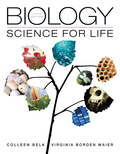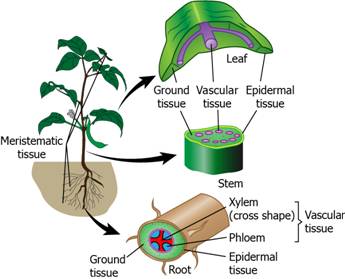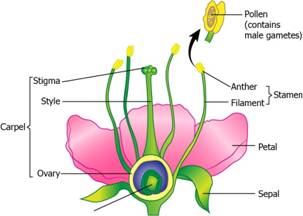
Concept explainers
To describe:
The parts of the plant and the flower.
Introduction:
The plants are the living things, which are able to produce the food by using sunlight, water and carbon dioxide. They synthesize their food in the process known as photosynthesis.
Explanation of Solution
The plant can be broadly divided into two main body, the root system and the shoot system. The root system is the part of the plant present inside the ground and the shoot system is the part of the plant present above the ground. The root has one main body, which is known as the tap root. This body gives rise to the branch roots, which are smaller and widespread in the soil.
The shoot system mainly consists of stem, branches and the leaves. The stem is a long solid pipe like structure that give rise to the branches. The point where a branch emerges from the stem is called node. The space between two nodes is known as the internode. The branches further divided into the flat green surface known as leaf or leaf blade. The flowering plants have a bright color structure called flowers. The flower is the site of sexual reproduction in plants. The fruit is the food storage site of the plants, which are mostly consumed by the heterotrophs.
The stem is a solid structure made of three substances. The outer lining of the stem is known as the epidermal layer. The stem has a bundle of vascular tissues, that is xylem and the phloem and the remaining space is occupied by the ground substance.
A labeled diagram of the plant is given below:


The flower is the site of sexual reproduction in the plants. A typical flower has both male and female reproductive part, but some species may have a single sexual part. The structure of a flower consists of sepal, petal, carpel and stigma. The carpel is the female reproductive part and consists of stigma, style and ovary. The stigma receives the male pollen and style is the tube through which the pollen pass to the ovary. The ovary contains female gametes and ovule. The ovule forms the seed or the embryo. The male part is stamen, which consists of anther and filament. The anther contains the male gamete that is the pollen grain.
A labeled diagram of a flower is given below:

The plant body consists of root and shoot system and the flower consists of sepals, petals, carpel and stamen.
Want to see more full solutions like this?
- For short answer questions, write your answers on the line provided. To the right is the mRNA codon table to use as needed throughout the exam. First letter U บบบ U CA UUCPhe UUA UCU Phe UCC UUG Leu CUU UAU. G U UAC TV UGCys UAA Stop UGA Stop A UAG Stop UGG Trp Ser UCA UCG CCU] 0 CUC CUA CCC CAC CAU His CGU CGC Leu Pro CCA CAA Gin CGA Arg CUG CCG CAG CGG AUU ACU AAU T AUC lle A 1 ACC Thr AUA ACA AUG Mot ACG AGG Arg GUU GCU GUC GCC G Val Ala GAC Asp GGU GGC GUA GUG GCA GCG GAA GGA Gly Glu GAGJ GGG AACASH AGU Ser AAA1 AAG Lys GAU AGA CAL CALUCAO CAO G Third letter 1. (+7) Use the table below to answer the questions; use the codon table above to assist you. The promoter sequence of DNA is on the LEFT. You do not need to fill in the entire table. Assume we are in the middle of a gene sequence (no need to find a start codon). DNA 1 DNA 2 mRNA tRNA Polypeptide C Val G C. T A C a. On which strand of DNA is the template strand (DNA 1 or 2)?_ b. On which side of the mRNA is the 5' end (left or…arrow_forward3. (6 pts) Fill in the boxes according to the directions on the right. Structure R-C R-COOH OH R-OH i R-CO-R' R R-PO4 R-CH3 C. 0 R' R-O-P-OH 1 OH H R-C-H R-N' I- H H R-NH₂ \H Name Propertiesarrow_forward4. (6 pts) Use the molecule below to answer these questions and identify the side chains and ends. Please use tidy boxes to indicate parts and write the letter labels within that box. a. How many monomer subunits are shown? b. Box a Polar but non-ionizable side chain and label P c. Box a Basic Polar side chain and label BP d. Box the carboxyl group at the end of the polypeptide and label with letter C (C-terminus) H H OHHO H H 0 HHO H-N-CC-N-C-C N-C-C-N-GC-OH I H-C-H CH2 CH2 CH2 H3C-C+H CH2 CH2 OH CH CH₂ C=O OH CH2 NH2arrow_forward
- please draw in what the steps are given. Thank you!arrow_forwardplease draw in and fill out the empty slots from image below. thank you!arrow_forwardThere is a species of eagle, which lives in a tropical forest in Brazil. The alula pattern of its wings is determined by a single autosomal gene with four alleles that exhibit an unknown hierarchy of dominance. Genetic testing shows that individuals 1-1, 11-4, 11-7, III-1, and III-4 are each homozygous. How many possible genotypes among checkered eagles in the population?arrow_forward
 Biology: The Unity and Diversity of Life (MindTap...BiologyISBN:9781305073951Author:Cecie Starr, Ralph Taggart, Christine Evers, Lisa StarrPublisher:Cengage Learning
Biology: The Unity and Diversity of Life (MindTap...BiologyISBN:9781305073951Author:Cecie Starr, Ralph Taggart, Christine Evers, Lisa StarrPublisher:Cengage Learning





